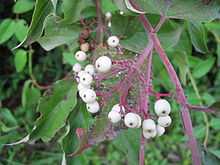Cornus racemosa
| Cornus racemosa | |
|---|---|
 | |
| Berries | |
| Scientific classification | |
| Kingdom: | Plantae |
| (unranked): | Angiosperms |
| (unranked): | Eudicots |
| (unranked): | Asterids |
| Order: | Cornales |
| Family: | Cornaceae |
| Genus: | Cornus |
| Subgenus: | Swida |
| Species: | C. racemosa |
| Binomial name | |
| Cornus racemosa Lam. | |
 | |
| Natural range of Cornus racemosa | |
Cornus racemosa (northern swamp dogwood, gray dogwood or panicle dogwood) is a shrubby plant native to southeastern Canada and the northeastern United States. It is a member of the dogwood genus Cornus and the family Cornaceae.
Plants can produce many stems and suckers, with older stems, which can reach 5 metres (16 ft) in height, having distinctive gray bark. The plant grows upright with a rounded habit and oppositely arranged leaves and terminally born flowers. The white flowers are small, with four petals, and clustered together in rounded, 2-inch-wide (51 mm) clusters called cymose panicles, produced in May and early June. After flowering, green fruits are produced that turn white in late summer. The white fruits, or drupes, are attached to the plant by bright red pedicels. Many species of birds feed on the fruits. Old branches grow slowly, while new stems are fast growing. In the fall the foliage can take on a reddish or purplish color, though it is not overly showy from a distance.
A synonymous name for the species is Swida racemosa.
External links
- Cornus racemosa description with pictures
- USDA Description
- NRCS: USDA Plants Profile: Cornus racemosa
- Brief description and pictures
| Wikimedia Commons has media related to Cornus racemosa. |